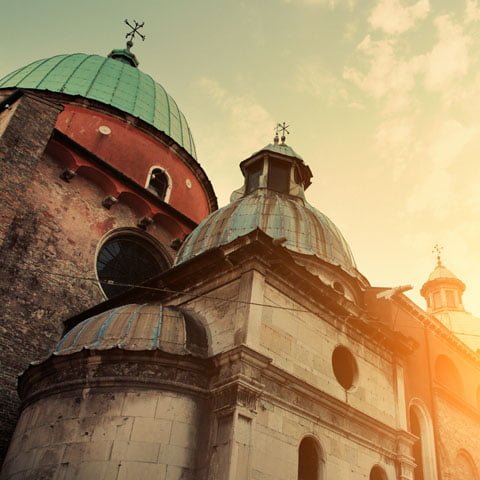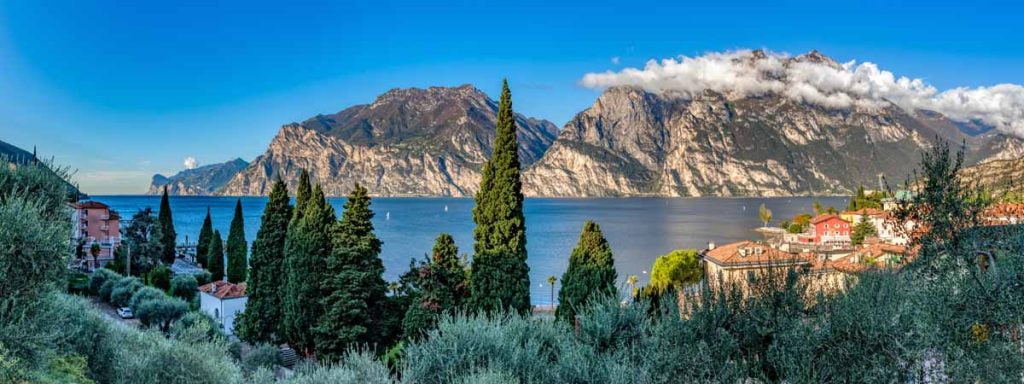The city of Treviso, which is one of the hubs of Northern Italy’s Veneto region, is characterized by a long past that most likely began with the Celts. The city’s golden period occurred during the Middle Ages when it was home to an important mint. The historic city center of Treviso is surrounded by medieval walls constructed during the rule of the Republic of Venice that still stand to this day. Under the Venetians, Treviso served as a border town that guarded the Republic’s northwestern frontier.
Like Venice, Treviso is a city of water, as it sits at the confluence of several rivers, the most important being the Sile River. Treviso’s rich culture can be measured by its wealth of frescoes, namely those by Tommaso da Modena, as well as its medieval architecture. Though much of the city’s architecture was destroyed during World War II bombings, the city center was subsequently restructured and restored. Treviso is also known for its native culinary products, such as radicchio and Prosecco wine.
Today, the province of Treviso serves as the headquarters of several important Italian retailers and manufacturers including Benetton, Geox, De’Longhi, and Pinarello. Despite the international fame of nearby Venice, Treviso stands on its own as a tourism center thanks to its historic frescoes, architecture, and natural scenery.
PREHISTORY OF TREVISO
The etymology of the word “Treviso” can be traced back to two possible interpretations. In the first, the word would derive from the Celtic tarvos, which means “bull”, with the addition of the Latin ending isium resulting in Tarvisium. For the second, there would be a link with the name of a Proto-Venetian tribe that first settled there.
There is evidence of a settlement in the Treviso area as early as the Bronze Age. Many civilizations were attracted to the area thanks to the abundance of water and fertile soil.
With the advent of the Roman Empire, however, Treviso became an important commercial center, acquiring Roman citizenship. It was during the Roman period that Christianity spread to Treviso.
HISTORY OF TREVISO
Like all of the Italic lands at the time, Treviso underwent a demographic and economic decline after the fall of the Roman Empire, yet — spared by Attila the Hun — the city flourished under the Goths. In 568 AD, Treviso fell to the Lombards who made the city a duchy.
Charlemagne made Treviso the capital of a border march, the Marca Trevigiana, which today corresponds to the modern province of Treviso. Subsequently, the Carolingians gave orders for the construction of a mint which, having flourished in the ninth century, was an unequivocal sign of a renowned prestige that has continued until now. The city was then devastated by the Hungarians. In 911 AD, the city began to develop its municipal regulations, recognized in 1164 by Emperor Frederick Barbarossa.
During the Middle Ages, Treviso joined the Lombard League, which was the alliance of cities in Northern Italy that, in the twelfth and thirteenth centuries, resisted attempts by the Holy Roman Emperors to reduce the liberties and jurisdiction of the communes of Lombardy. In 1183, Treviso gained independence following the Peace of Costance.
It was also during this period that various noble families ruled over Treviso, such as the Ezzelini family (also known as Da Romano). Struggles between the Guelph and Ghibelline factions followed. Despite the turmoil among Treviso’s ruling classes, the city experienced significant economic and cultural growth.
This was a particularly flourishing period for the city of Treviso which, after having extended its domain, embellished itself with poets recounting the city’s beauties.
In 1237, Ezzelino and Alberico da Romano put an end to the period of peace and serenity reached by the municipality of Treviso, taking possession of the city. Upon their death, the city reverted to independence, but soon new wars arose between the Guelph and Ghibelline factions, aimed at bringing a new imbalance.
The leader of the Guelphs, Gherardo da Camino, became lord of the city in 1283 and governed it wisely highlighting the prestige of the Treviso.
Treviso then found itself under the dominion of the counts of Gorizia and other imperial vicars. In 1328 it was the Scaligeri’s turn until 1339, when Treviso was acquired by Venice and became the first notable mainland possession of the Serenissima.
Treviso became involved in the wars of Venice and in 1381 the city was given to the Duke of Austria. From 1381 the city was ruled by Leopoldo of Austria, who in 1384 sold it to the despotic Carraresi of Padua.
For strategic reasons the Visconti took possession of the city and managed to exercise rigorous control until 1389 when Treviso’s people, tired of the continuous changes of ownership, spontaneously conceded to Venice, which resulted in peace and benefits.
The city shared the fate of the Venetian Republic until 1797, when it was taken by the French armies of Napoleon. It then passed to Austria, then to the Kingdom of Italy (1805), and again to Austria (1813).
In 1848, Treviso followed in the revolution against the Austrians, and was annexed with the rest of Veneto to the Kingdom of Italy in 1866.
During World War I, Treviso suffered greatly due to the aerial bombardments that destroyed a large part of the city. However, the damage was even worse during World War II, when Treviso suffered a bombing that resulted in thousands of victims and destroyed public buildings and monuments of considerable historical and artistic interest, including a large part of the medieval structures of the city center.
After the war and the proclamation of the Italian Constitution, the reconstruction of the city began. The reconstruction involved many buildings including Palazzo dei Trecento, partially bombed in 1944. Roads and public lighting were also improved.
Small and medium-sized industries developed, and Treviso soon became one of the most economically lively cities in Italy.
ARCHEOLOGY IN TREVISO
The city center of Treviso houses the remains of a paleo-Christian baptistery underneath Via Canoniche. The surviving ruins of the circular baptistery include segments of the structure and several large mosaic fragments. Excavated during the mid-twentieth century, the remains sit at the heart of the original Roman city.
Other interesting archeological sites within the province of Treviso include the Roman walls, Roman roads, Roman mosaics, and the Roman Forum in Oderzo as well as the Roman Theater in Asolo.
Travel Guides
The Veneto Region of Italy
The Cities of Veneto, Italy







